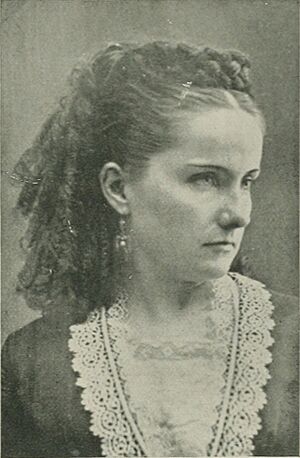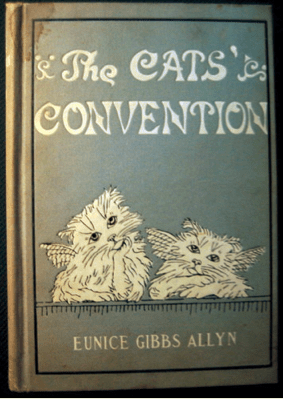Eunice Gibbs Allyn facts for kids
Quick facts for kids
Eunice Gibbs Allyn
|
|
|---|---|

"A Woman of the Century"
|
|
| Born | Eunice Eloisae Gibbs 1847 Brecksville, Ohio, US |
| Died | June 30, 1916 (aged 68–69) Dubuque, Iowa |
| Pen name | (multiple) |
| Occupation | correspondent, author, songwriter, illustrator, painter |
| Language | English |
| Nationality | American |
| Genre | poetry, prose |
| Notable works | The Cats' Convention |
| Spouse |
Glarence Gilman Allyn
(m. 1873; died 1911) |
| Relatives | Harriet Bishop (mother's cousin), Mary Newbury Adams (aunt) |
Eunice Gibbs Allyn (born Eunice Eloisae Gibbs, 1847 – June 30, 1916) was a talented American writer, songwriter, artist, and painter. She wanted to be a teacher, but her mother encouraged her to stay home. Eunice wrote for local newspapers using different pen names. She did this because one of her brothers did not want a "bluestocking" (a woman who was too interested in books and learning) in the family.
Allyn worked as a reporter in Washington, D.C., for the Chicago Inter Ocean newspaper. She also wrote for the St. Louis Globe-Democrat and the New York World. She became well-known as an artist and speaker. For eight years, she was the president of the Dubuque branch of the Woman's Christian Temperance Union (WCTU). This group worked to improve society and help people.
Contents
Early Life and Education
Eunice Eloisae Gibbs was born in 1847. Her hometown was Brecksville, Ohio, near Cleveland. Her father, Dr. Sidney Smith Gibbs, was a doctor from New York. Her mother, Eunice Lucinda Newberry, was a successful teacher.
Eunice was the third of four children. Her father died when she was young. After his death, her family moved to Cleveland. Eunice graduated from high school there with high honors. She was also a niece of Mary Newbury Adams and her mother was a cousin of Harriet Bishop.
A Creative Career Begins
Eunice Allyn first wanted to become a teacher. However, her mother suggested she stay home. Eunice then began writing for local newspapers. She used different pen names to sign her articles. This was because her brother did not want her to be seen as a "bluestocking."
Her first poems were published when she was just thirteen. They appeared in the Cleveland Plain Dealer newspaper. Besides poems, she often wrote songs, including both the words and the music. She created songs when she couldn't find the right ones for different events.
Marriage and Writing Success
In 1873, Eunice married Glarence Gilman Allyn. He was from Nyack, New York. They lived in several cities before settling in Dubuque, Iowa.
Before her marriage, Eunice worked as a Washington correspondent. She reported for the Chicago Inter Ocean for a year. During this time, she also wrote many articles. Her work appeared in the St. Louis Globe-Democrat and the New York World. She also wrote for many other newspapers in major cities. Eunice was known for her sharp and clear writing style. All her work, whether prose or poetry, had a clear purpose or main idea.
Allyn as an Artist
Eunice Allyn also became a distinguished artist. Several of her landscape paintings were shown at the 1904 St. Louis World's Fair. In 1910, one of her paintings was added to the permanent art collection. This collection is at the Carnegie-Stout Public Library in Dubuque.
In 1909, she published a book called The Cats' Convention. She also illustrated the book herself. It included drawings of many different cats, some beautiful and some funny. This book is now part of the Iowa Collection. It is kept at the State Historical Society of Iowa.
Personal Life and Community Work
In Dubuque, Eunice Allyn started many important projects. These included reforms and educational programs. She did this work not for fame, but because she wanted to help people.
Allyn was an important member of the Dubuque Ladies' Literary Union. She also served as president for eight years. This was for the Dubuque branch of the WCTU. This organization worked to improve society and support families.
When she was a child, Eunice received a special gift. It was a daguerreotype (an early type of photograph) of Hole in the Day. This gift came from Harriet Bishop, her mother's cousin. In 1903, Allyn gave this daguerreotype to the Minnesota Historical Society.
Eunice was a member of the Episcopal Church. She also greatly admired Oriental philosophy.
Eunice Gibbs Allyn passed away at her home in Dubuque. She died on June 30, 1916, after a long illness. She and her husband are buried at Linwood Cemetery in Dubuque. Before her death, people began collecting her writings. They wanted to preserve her literary works. These are now kept in the Iowa state historical archives.
Selected Works
- "Her one star" (words and music)
- "Vesper bells" (words and music)
- "The King of all painters", 1898 (words and music)
- "The Thanksgiving hymn of the Republic", 1898 (words and music)
- "One thousand smiles", 1898
- "The Evolution of the Greek Flat", 1907
- "My Spirit Wife", 1909 (short story)
- The Cats' Convention, 1909


